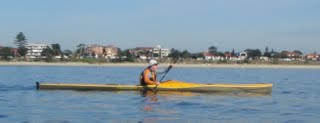 It’s just gone a year since a few hardy souls began to gather at the Kyeemagh boat ramp adjacent to Botany Bay each Wednesday morning for a nose-to-the-keel fitness paddle, about 12.5km to Dolls Pt in the south of the Bay & back again.
It’s just gone a year since a few hardy souls began to gather at the Kyeemagh boat ramp adjacent to Botany Bay each Wednesday morning for a nose-to-the-keel fitness paddle, about 12.5km to Dolls Pt in the south of the Bay & back again.Over this period, the core of the group, namely Peter Levy, Roger Boardman & Duncan Stoddart have been stalwarts, with a few guest appearances from Bare Island Park Ranger Ben Khan, Kate Nichols, Raewyn Duffy, and cameos from Dee Ratcliffe, Matt Bezzina & Harry Havu.
It’s worth looking back over a period of time at what is essentially a training paddle, to see if there have been any tangible improvements to your paddling, as a result of dedicating some time each week to pushing yourself past the comfort zone.
In my own case I quickly realised that my paddling style had been shaped by the slow upper or hull speeds of the sea kayaks I paddle. In other words, I was conditioned to a certain cadence & stroke that suited the fact that pretty much no matter what I did, on dead flat water my boat couldn’t really go any faster than about 9kmh over a sustained distance. So, I had a slow, powerful stroke that didn’t lend itself to improving overall fitness, or the muscle memory required to accelerate when I transferred my paddling to the dynamic water of the sea.
I also came very quickly to the conclusion that wing paddle I was using was too long, too big in the face & set at the wrong feather.
Wing paddles have become an odd point of contention in our club, and I think this mainly stems from the poor technique many paddlers employ in using them. To get anything at all out of a wing, your stroke needs to be upright, your catch close & you need to rotate quickly out of the water. If you have a low ‘army’ stroke you will fight the design of a wing every inch of the way & get no discernable benefit from using it. You’ll also have a few problems when it comes to using the blade for technical strokes, unless you have really dedicated yourself to learning the nuances required to paddle ‘technically’ with a wing.
My own big bastard of a wing was quickly discarded in favour of a much smaller mid-sized blade with a percentage of glass in the shaft, rather than a stiff, pure carbon pipe.
I also did away with the idea of paddling a traditional sea kayak & went instead for the Rapier 20, a radical design with a much more surf-ski like hull, capable of a top speed that as yet, I’m incapable of reaching.
The result has been a steady increase in my ability to reach a high cadence & sustain it over 75-80 minutes. I’m going about 15% faster compared to the same times in my Rapier 8 months ago, and can crack & hold 10kmh+ for about 50 minutes before my otherwise lacklustre fitness tanks!
I don’t think any of the guys who have been regulars would claim anything other than improvements in their paddling as a result of these weekly sessions, and we all watch one another’s strokes etc & offer advice if someone is getting into bad habits.
Transferring the increased ability to accelerate into my sea paddling, I find that I’m much better at catching the free rides on offer from the sea & swell, and have much better skills at powering my way out of trouble when required. It’s ironic that the metronomic high cadence of a fitness paddle is the antithesis of the paddling style I’ve developed in the ocean, which is more a series of bursts as I try to time my powerful strokes with the ‘kick up the bum’ that following conditions or rebound offer. I also get bored senseless by the trips where everyone is bee-lining from headland to headland in some bizarre todger-waving exercise to see who can go the fastest. Give me a 20km paddle over 4 hours with some caves, rebound, surf & some skills practice anytime over the ‘out & back, quick as you can’ day trips.
So, I hope I can speak for my hardy Wednesday morning mates when I say that you can’t get enough out of a regular paddle in your routine which is dedicated to building fitness & forward paddle technique.
Our paddles leave at 6.30am sharp each Wednesday from Kyeemagh Boat Ramp in Sydney, if you’re interested in coming along.



No comments:
Post a Comment